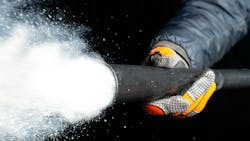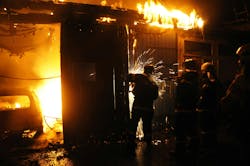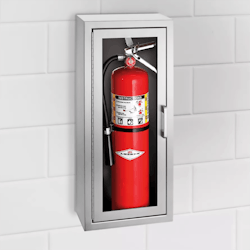In this article, you'll learn about:
- Some recent shop fire incidents and how they were caused
- How to start thinking about fire safety in the shop
- What to do in the event of a shop fire
Even new technicians know what to watch out for in the shop when it comes to preventing obvious fires. It’s common sense not to weld around diesel containers or set a blowtorch down near a puddle of oil, for example. But shops are full of flammable materials and fire hazards even where you least suspect it.
“I’ve had a few cases where shops have blown out their entire paint booth,” SeaRay Beltran, safety oversight consultant with PIRM Group International, told Fleet Maintenance. “People don’t realize that combustible dust mixed with fumes and paint when they blast, they don’t just explode and burn. They’ll explode and take the roof off or the walls of a building based on the structure that’s built.”
The formula for fire is simple, requiring a lot less than you may think. Fuel, heat, and oxygen are the only ingredients, and commercial vehicle shops have plenty of all three, making them a high-risk environment.
There are a number of common issues in the shop environment, including “electrical hazards like faulty wiring or overloaded circuits, flammable liquids like oils and solvents, built-up grease and oil residue, improper storage of combustible materials, and more, all of which can easily ignite when exposed to a heat source,” Beltran explained.
Add a catalyst like a rogue spark from a welding machine or a chemical reaction, and your business could go up in flames—along with you, your employees, and customers. But just remove any of these components and you can snuff out such possibilities. Proper planning and precautionary measures can go a long way toward preventing fires, but you have to be the catalyst for that. For some practical guidance on how to make your shop more fire-proof, we talked to several experts who have seen firsthand just how quickly one mistake could spark a disaster.
Common fire types in the shop
- Class A: Ordinary Combustibles (wood, paper, cloth)
How to fight: Water, ABC extinguishers - Class B: Flammable Liquids (oil, fuel, grease)
How to fight: Foam, CO2 extinguishers (never H20) - Class C: Electrical (wiring, outlets)
How to fight: CO2, ABC and BC extinguishers - Class D: Combustible Metals (magnesium, aluminum shavings)
How to fight: Class D Extinguishers
Source: NFPA
How do they happen?
Just last March, a shop fire in Stearns County, Minnesota destroyed eight of a fleet’s 30 trucks in addition to one of the buildings. According to those present, by the time they noticed smoke and someone ran to get an extinguisher, the shop was too smoky to re-enter. Thankfully, nobody was hurt, but the financial loss was catastrophic.
Fires caused over $450 million of industrial property loss between 2018 and 2022, according to the National Fire Protection Association (NFPA), and much of that damage is entirely preventable.
“Awareness is probably one of the biggest factors,” said Timothy S. Cowan, Deputy Fire Chief, DeWitt Fire District in New York. “I get it, shops are busy. But if they’re not specifically aware of what their surroundings are and they’re just doing work... I think we’ve all seen enough videos where this stuff happens, and they don’t even realize it happens. And it could be too late.”
Sometimes the biggest issue comes down to plain old messiness and disorganization.
One of the most common fire risks is “poor housekeeping,” Cowan stated. “When things are unorganized, safety is definitely not the first priority. You can tell.”
Steve Eyer, engineering systems national sales manager at safety container provider Denios, agreed.
“Cleaning up incidental spills should already be a best practice for professional shops; however bad hygiene and improper storage of cleaning agents, solvents, etc. increases risks of fire,” he said.
Making sure that tools and used rags are properly stored and put away after use not only keeps potentially flammable items away from heat sources, but reduces overall clutter that could end up hazardous in the event of an emergency situation.
If employees are at least taking a look around before clocking out to make sure everything is back where it should be, Cowan said, that’s a step in the right direction.
First steps
PIRM’s Beltran recommended that the first step for a shop is to ensure that they are compliant with OSHA requirements and NFPA recommendations for vehicle repair shops, mentioning that on top of the actual fire safety benefits, this helps avoid violations and fines during inspection. It’s also important to comply with any local fire code requirements.
Abiding by regulations is a good start, but as technicians know, it takes more than rules and SOPs to get things done.
Calling a local fire department and asking for guidance is the next best step, Beltran suggested, emphasizing that they are usually willing to come let a shop know what might be missing from their fire-prevention plan and what they should pay attention to, as proactivity is always better than having to come put out a fire.
The experts agreed that shops often run into a few of the same mistakes when implementing fire-proofing measures and addressing hazards, one of which is lack of or inadequate employee training on identifying and fighting fire.
“It’s mandatory by federal and state OSHA programs that vehicle technicians and staff should absolutely receive training on fire prevention and firefighting,” Beltran said, “including the ability to identify different types of fires and how to properly extinguish them using appropriate methods.”
Training doesn’t have to be stressful, however, and again, local fire departments can help instruct employees on how to respond in the event of fire, including how to use extinguishers.
“Having the extinguisher is one thing, but not being able to use it correctly and not being trained on it sometimes makes things worse,” said Capt. Mike Daley, chief training officer and fire officer with Fire Service Performance Concepts, “and if you grab the wrong extinguisher for the wrong kind of fuel, it can also make things worse.”
There are also a whole host of potential issues that shop personnel may not even be aware of, and things like improper placement of fire alarms, neglecting regular maintenance, not addressing blocked exits, using extension cords improperly, failing to update fire protection systems, and more are not uncommon to encounter when inspecting a shop, according to Beltran.
The easy solution here is to leave things to the experts, and luckily, most fire departments are available to lend a helping hand beyond just training.
“Are the extinguishers checked every month? Is extinguisher training done annually? Are they up to date? Are they filled? Have they been inspected?” asked Daley, who was a diesel mechanic for 20 years. “There are lots of shops and repair facilities that are really diligent on that stuff, and unfortunately, I’m sure there are a few that sneak by and aren’t.”
Shop managers already have plenty on their plate, and requesting training and inspection from those who know exactly what to look for is the best way to prevent hazards from slipping through the cracks.
“I think people want to comply, but they don’t know what they don’t know. And I think that that’s our job as the fire service to educate them,” Cowan offered. “I think if we can bridge that gap between the fire service and fleet managers and mechanics and shops to say, ‘This is why this is important,’ I think you got it licked after that point.”
Know the drill
Preparation is great, but what happens if a fire happens? Have a plan. Managers should ensure that their employees know the drill, literally.
“Are they training their employees to use fire extinguishers, or are they just training their employees to get out? How do they mass notify their people?” Cowan asked. “I’ve seen some dealerships have 40 bays and if a fire starts on one end, how do you communicate that to the other end?”
These are all things that should be part of a concrete plan, but the best first step to take when disaster strikes is call 911, even if you think the situation might be under control.
“Even if it’s a flash fire that the shop technicians might have put out, fire departments are carrying thermal imaging devices and other devices that can confirm that temperatures are down and the fire is completely out,” Daley explained.
The next thing, Cowan said, is to think about others who may be in danger. For example, a showroom full of customers connected to the shop.
“Let’s say it’s a dealership,” he posed. “Now we’ve got to do some evacuation.”
The rest may vary based on the size of the shop, layout, where the fire is, how quickly it is spreading, etc.
Daley discussed a situation in which a fire started just outside of a repair shop, and quick thinking by the technicians present helped mitigate the situation.
“One of the smartest things that the shop did was close the bay doors, so that the fire was already outside and stayed outside instead of coming into the building.”
However, acting impulsively can have unintended consequences, making things worse. Daley mentioned another example of technicians doing their best to mitigate a fire that didn’t help the situation overall.
“It was a fuel tank that started to burn, and as it was moved, the fuel started to spill and the fire started to spread,” he recalled. “So again, the best thing to do is just call the fire department.”
The bottom line is that for things to go as smoothly as possible if an emergency situation arises and to keep damage to a minimum, managers should make sure it’s not the first time they’re talking about fire safety with their employees.
“All that promulgation of practicing fire safety and actually going through this with their employees pays off in dividends when something happens,” Cowan concluded.
About the Author

Lucas Roberto
Lucas Roberto is an Associate Editor for Fleet Maintenance magazine. He has written and produced multimedia content over the past few years and is a newcomer to the commercial vehicle industry. He holds a bachelor's in media production and a master's in communication from High Point University in North Carolina.


